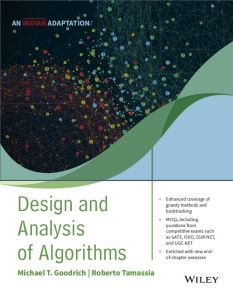Design and Analysis of Algorithms (An Indian Adaptation)
ISBN: 9789354248481
624 pages
For more information write to us at: acadmktg@wiley.com

Description
Design and Analysis of Algorithms offers an exhaustive coverage of the design and analysis of algorithms and data structures. Integrating application with theory, the book presents algorithmic topics in a context that is motivated from applications to uses in society, computer games, computing industry, science, engineering, and the Internet. Beginning with the basic framework and tools needed to analyze algorithms, the book then presents fundamental data structures, such as stacks, queues, lists, and advanced data structures such as trees, search trees, priority queues, heaps, hash tables, union-find structures, and graphs.
Table of Contents
1 Algorithm Analysis
1.1 Analyzing Algorithms
1.2 A Quick Mathematical Review
1.3 A Case Study in Algorithm Analysis
1.4 A Case Study in Designing an Algorithm
1.5 Amortization
2 Basic Data Structures
2.1 Stacks and Queues
2.2 Vectors, Lists, and Sequences
2.3 Trees
3 Binary Search Trees
3.1 Searches and Updates
3.2 Range Queries
3.3 Index-Based Searching
4 Balanced Binary Search Trees
4.1 Ranks and Rotations
4.2 AVL Trees
4.3 Red-Black Trees
4.4 Weak AVL Trees
4.5 Splay Trees
5 Priority Queues and Heaps
5.1 Priority Queues
5.2 PQ-Sort, Selection-Sort, and Insertion-Sort
5.3 Heaps
5.4 Extending Priority Queues
6 Hash Tables
6.1 Maps
6.2 Hash Functions
6.3 Handling Collisions and Rehashing
6.4 Cuckoo Hashing
6.5 Universal Hashing
7 Union-Find Structures
7.1 Union-Find and Its Applications
7.2 A List-Based Implementation
7.3 A Tree-Based Implementation
8 Graphs and Traversals
8.1 Graph Terminology and Representations
8.2 Depth-First Search
8.3 Breadth-First Search
8.4 Directed Graphs
8.5 Biconnected Components
8.6 Single-Source Shortest Paths
9 Sorting Algorithms
9.1 Merge-Sort
9.2 Quick-Sort
9.3 A Lower Bound on Comparison-Based Sorting
9.4 Heap-Sort
10 Fast Sorting and Selection
10.1 Bucket-Sort and Radix-Sort
10.2 Selection
10.3 Weighted Medians
11 Divide-and-Conquer
11.1 Recurrences and the Master Theorem
11.2 Maxima and Minima Problem
11.3 Integer Multiplication
11.4 Matrix Multiplication
11.5 The Maxima-Set Problem
11.6 Order Statistics – Selection Problem
11.7 Shortest Paths in Directed Acyclic Graphs
12 The Greedy Method
12.1 The Fractional Knapsack Problem
12.2 Bin Packing
12.3 Task Scheduling
12.4 Text Compression and Huffman Coding
12.5 Coin Change Problem
12.6 Optimal Tape Storage Problem
13 Dynamic Programming
13.1 Binomial Coefficient
13.2 Matrix Chain-Products
13.3 The General Technique
13.4 Telescope Scheduling
13.5 Game Strategies
13.6 The Longest Common Subsequence Problem
13.7 The 0–1 Knapsack Problem
13.8 The Bellman-Ford Algorithm
13.9 All-Pairs Shortest Paths
13.10 Dijkstra’s Algorithm
14 Minimum Spanning Trees
14.1 Properties of Minimum Spanning Trees
14.2 Kruskal’s Algorithm
14.3 The Prim-Jarník Algorithm
14.4 Baruvka’s Algorithm
15 NP-Completeness
15.1 P and NP
15.2 NP-Completeness
15.3 CNF-SAT and 3SAT
15.4 VERTEX-COVER, CLIQUE, and SET-COVER
15.5 SUBSET-SUM and KNAPSACK
15.6 HAMILTONIAN-CYCLE and TSP
16 Approximation Algorithms
16.1 The Metric Traveling Salesperson Problem
16.2 Approximations for Covering Problems
16.3 Polynomial-Time Approximation Schemes
16.4 Backtracking and Branch-and-Bound
17 Text Processing
17.1 Strings and Pattern Matching Algorithms
17.2 Tries
18 Number Theory, Cryptography, and Fast Fourier Transform
18.1 Fundamental Algorithms Involving Numbers
18.2 Cryptographic Computations
18.3 Information Security Algorithms and Protocols
18.4 The Fast Fourier Transform
19 Network Flow and Matching
19.1 Flows and Cuts
19.2 Maximum Flow Algorithms
19.3 Maximum Bipartite Matching
19.4 Baseball Elimination
19.5 Minimum-Cost Flow
20 Randomized Algorithms
20.1 Generating Random Permutations
20.2 Stable Marriages and Coupon Collecting
20.3 Minimum Cuts
20.4 Finding Prime Numbers
20.5 Chernoff Bounds
20.6 Skip Lists
Appendix A Backtracking
A.1 Generating Binary Strings
A.2 Fundamental Concept of Effective Backtracking Paradigm
A.3 Hamiltonian Cycle Problem
A.4 Traveling Salesman Problem
A.5 Eight Queens Puzzle
A.6 Combination as a Base Object for Backtracking
A.7 Clique Problem
Appendix B Useful Mathematical Facts
B.1 Logarithms and Exponents
B.2 Integer Functions and Relations
B.3 Summations
B.4 Basic Probability
B.5 Useful Mathematical Techniques
Bibliography
Index
Supplements

